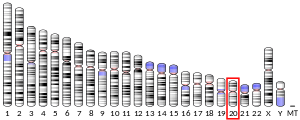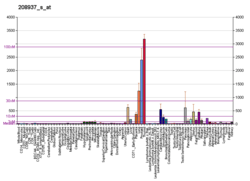ID1
DNA-binding protein inhibitor ID-1 is a protein that in humans is encoded by the ID1 gene.[5][6]
Function
The protein encoded by this gene is a helix-loop-helix (HLH) protein that can form heterodimers with members of the basic HLH family of transcription factors.[5] The encoded protein has no DNA binding activity and therefore can inhibit the DNA binding and transcriptional activation ability of basic HLH proteins with which it interacts.[5] This protein may play a role in cell growth, senescence, and differentiation.[7][8][9] Two transcript variants encoding different isoforms have been found for this gene.[10]
Interactions
ID1 has been shown to interact weakly with MyoD[5][11][12][13][14][15][16] but very tightly with ubiquitously expressed E proteins.[17] E proteins heterodimerize with tissue restricted bHLH proteins such as Myod, NeuroD, etc. to form active transcription complexes so by sequestering E proteins, Id proteins can inhibit tissue restricted gene expression in multiple cell lineages using the same biochemical mechanism. Other interacting partners include CASK.[18]
Clinical significance
ID1 can be used to mark endothelial progenitor cells which are critical to tumor growth and angiogenesis.[19][20] Targeting ID1 results in decreased tumor growth.[21][22]
See also
References
- GRCh38: Ensembl release 89: ENSG00000125968 - Ensembl, May 2017
- GRCm38: Ensembl release 89: ENSMUSG00000042745 - Ensembl, May 2017
- "Human PubMed Reference:". National Center for Biotechnology Information, U.S. National Library of Medicine.
- "Mouse PubMed Reference:". National Center for Biotechnology Information, U.S. National Library of Medicine.
- Benezra R, Davis RL, Lockshon D, Turner DL, Weintraub H (1990). "The protein Id: a negative regulator of helix-loop-helix DNA binding proteins". Cell. 61 (1): 49–59. doi:10.1016/0092-8674(90)90214-Y. PMID 2156629.
- Hara E, Yamaguchi T, Nojima H, Ide T, Campisi J, Okayama H, Oda K (February 1994). "Id-related genes encoding helix-loop-helix proteins are required for G1 progression and are repressed in senescent human fibroblasts". J Biol Chem. 269 (3): 2139–45. PMID 8294468.
- Ruzinova MB, Benezra R (2003). "Id proteins in development, cell cycle and cancer". Trends in Cell Biology. 13 (8): 410–8. doi:10.1016/S0962-8924(03)00147-8. PMID 12888293.
- Perk J, Iavarone A, Benezra R (2005). "The Id family of helix-loop-helix proteins in cancer". Nat Rev Cancer. 5 (8): 603–614. doi:10.1038/nrc1673. PMID 16034366.
- Cunningham, Thomas J.; Yu, Michael S.; McKeithan, Wesley L.; Spiering, Sean; Carrette, Florent; Huang, Chun-Teng; Bushway, Paul J.; Tierney, Matthew; Albini, Sonia; Giacca, Mauro; Mano, Miguel; Puri, Pier Lorenzo; Sacco, Alessandra; Ruiz-Lozano, Pilar; Riou, Jean-Francois; Umbhauer, Muriel; Duester, Gregg; Mercola, Mark; Colas, Alexandre R. (1 July 2017). "Id genes are essential for early heart formation". Genes & Development. 31 (13): 1325–1338. doi:10.1101/gad.300400.117. PMC 5580654. PMID 28794185.
- "Entrez Gene: ID1 inhibitor of DNA binding 1, dominant negative helix-loop-helix protein".
- Garkavtsev I, Kozin SV, Chernova O, Xu L, Winkler F, Brown E, Barnett GH, Jain RK (March 2004). "The candidate tumour suppressor protein ING4 regulates brain tumour growth and angiogenesis". Nature. 428 (6980): 328–32. doi:10.1038/nature02329. PMID 15029197.
- Langlands K, Yin X, Anand G, Prochownik EV (August 1997). "Differential interactions of Id proteins with basic-helix-loop-helix transcription factors". J. Biol. Chem. 272 (32): 19785–93. doi:10.1074/jbc.272.32.19785. PMID 9242638.
- Finkel T, Duc J, Fearon ER, Dang CV, Tomaselli GF (January 1993). "Detection and modulation in vivo of helix-loop-helix protein-protein interactions". J. Biol. Chem. 268 (1): 5–8. PMID 8380166.
- Gupta K, Anand G, Yin X, Grove L, Prochownik EV (March 1998). "Mmip1: a novel leucine zipper protein that reverses the suppressive effects of Mad family members on c-myc". Oncogene. 16 (9): 1149–59. doi:10.1038/sj.onc.1201634. PMID 9528857.
- McLoughlin P, Ehler E, Carlile G, Licht JD, Schäfer BW (October 2002). "The LIM-only protein DRAL/FHL2 interacts with and is a corepressor for the promyelocytic leukemia zinc finger protein". J. Biol. Chem. 277 (40): 37045–53. doi:10.1074/jbc.M203336200. PMID 12145280.
- Ling MT, Chiu YT, Lee TK, Leung SC, Fung MK, Wang X, Wong KF, Wong YC (September 2008). "Id-1 induces proteasome-dependent degradation of the HBX protein". J. Mol. Biol. 382 (1): 34–43. doi:10.1016/j.jmb.2007.06.020. PMID 18674781.
- Jen Y, Weintraub H, Benezra R (August 1992). "Overexpression of Id protein inhibits the muscle differentiation program: in vivo association of Id with E2A proteins". Genes Dev. 6 (8): 1466–79. doi:10.1101/gad.6.8.1466. PMID 1644289.
- Qi J, Su Y, Sun R, Zhang F, Luo X, Yang Z, Luo X (March 2005). "CASK inhibits ECV304 cell growth and interacts with Id1". Biochem. Biophys. Res. Commun. 328 (2): 517–21. doi:10.1016/j.bbrc.2005.01.014. PMID 15694377.
- Lyden D, Young AZ, Zagzag D, Yan W, Gerald W, O'Reilly R, Bader BL, Hynes RO, Zhuang Y, Manova K, Benezra R (October 1999). "Id1 and Id3 are required for neurogenesis, angiogenesis and vascularization of tumour xenografts". Nature. 401 (6754): 670–7. doi:10.1038/44334. PMID 10537105.
- Lyden D, Hattori K, Dias S, Costa C, Blaikie P, Butros L, Chadburn A, Heissig B, Marks W, Witte L, Wu Y, Hicklin D, Zhu Z, Hackett NR, Crystal RG, Moore MA, Hajjar KA, Manova K, Benezra R, Rafii S (November 2001). "Impaired recruitment of bone-marrow-derived endothelial and hematopoietic precursor cells blocks tumor angiogenesis and growth". Nat. Med. 7 (11): 1194–201. doi:10.1038/nm1101-1194. PMID 11689883.
- Henke E, Perk J, Vider J, de Candia P, Chin Y, Solit DB, Ponomarev V, Cartegni L, Manova K, Rosen N, Benezra R (January 2008). "Peptide-conjugated antisense oligonucleotides for targeted inhibition of a transcriptional regulator in vivo". Nat. Biotechnol. 26 (1): 91–100. doi:10.1038/nbt1366. PMID 18176556.
- Mellick AS, Plummer PN, Nolan DJ, Gao D, Bambino K, Hahn M, Catena R, Turner V, McDonnell K, Benezra R, Brink R, Swarbrick A, Mittal V (September 2010). "Using the transcription factor inhibitor of DNA binding 1 to selectively target endothelial progenitor cells offers novel strategies to inhibit tumour angiogenesis and growth". Cancer Res. 70 (18): 7273–82. doi:10.1158/0008-5472.CAN-10-1142. PMC 3058751. PMID 20807818.
Further reading
- Zhu W, Dahmen J, Bulfone A, Rigolet M, Hernandez MC, Kuo WL, Puelles L, Rubenstein JL, Israel MA (1995). "Id gene expression during development and molecular cloning of the human Id-1 gene". Brain Res. Mol. Brain Res. 30 (2): 312–26. doi:10.1016/0169-328X(95)00017-M. PMID 7637581.
- Deed RW, Jasiok M, Norton JD (1994). "Nucleotide sequence of the cDNA encoding human helix-loop-helix Id-1 protein: identification of functionally conserved residues common to Id proteins". Biochim. Biophys. Acta. 1219 (1): 160–2. doi:10.1016/0167-4781(94)90261-5. PMID 8086456.
- Mathew S, Chen W, Murty VV, Benezra R, Chaganti RS (1996). "Chromosomal assignment of human ID1 and ID2 genes". Genomics. 30 (2): 385–7. doi:10.1006/geno.1995.0037. PMID 8586447.
- Nehlin JO, Hara E, Kuo WL, Collins C, Campisi J (1997). "Genomic organization, sequence, and chromosomal localization of the human helix-loop-helix Id1 gene" (PDF). Biochem. Biophys. Res. Commun. 231 (3): 628–34. doi:10.1006/bbrc.1997.6152. PMID 9070860.
- Anand G, Yin X, Shahidi AK, Grove L, Prochownik EV (1997). "Novel regulation of the helix-loop-helix protein Id1 by S5a, a subunit of the 26 S proteasome". J. Biol. Chem. 272 (31): 19140–51. doi:10.1074/jbc.272.31.19140. PMID 9235903.
- Langlands K, Yin X, Anand G, Prochownik EV (1997). "Differential interactions of Id proteins with basic-helix-loop-helix transcription factors". J. Biol. Chem. 272 (32): 19785–19793. doi:10.1074/jbc.272.32.19785. PMID 9242638.
- Yates PR, Atherton GT, Deed RW, Norton JD, Sharrocks AD (1999). "Id helix-loop-helix proteins inhibit nucleoprotein complex formation by the TCF ETS-domain transcription factors". EMBO J. 18 (4): 968–76. doi:10.1093/emboj/18.4.968. PMC 1171189. PMID 10022839.
- Outinen PA, Sood SK, Pfeifer SI, Pamidi S, Podor TJ, Li J, Weitz JI, Austin RC (1999). "Homocysteine-induced endoplasmic reticulum stress and growth arrest leads to specific changes in gene expression in human vascular endothelial cells". Blood. 94 (3): 959–67. PMID 10419887.
- Langlands K, Down GA, Kealey T (2000). "Id proteins are dynamically expressed in normal epidermis and dysregulated in squamous cell carcinoma". Cancer Res. 60 (21): 5929–33. PMID 11085505.
- Ohtani N, Zebedee Z, Huot TJ, Stinson JA, Sugimoto M, Ohashi Y, Sharrocks AD, Peters G, Hara E (2001). "Opposing effects of Ets and Id proteins on p16INK4a expression during cellular senescence". Nature. 409 (6823): 1067–70. doi:10.1038/35059131. PMID 11234019.
- Suzuki H, Fukunishi Y, Kagawa I, Saito R, Oda H, Endo T, Kondo S, Bono H, Okazaki Y, Hayashizaki Y (2001). "Protein-protein interaction panel using mouse full-length cDNAs". Genome Res. 11 (10): 1758–65. doi:10.1101/gr.180101. PMC 311163. PMID 11591653.
- Korchynskyi O, ten Dijke P (2002). "Identification and functional characterization of distinct critically important bone morphogenetic protein-specific response elements in the Id1 promoter". J. Biol. Chem. 277 (7): 4883–4891. doi:10.1074/jbc.M111023200. PMID 11729207.
- Jögi A, Persson P, Grynfeld A, Påhlman S, Axelson H (2002). "Modulation of basic helix-loop-helix transcription complex formation by Id proteins during neuronal differentiation". J. Biol. Chem. 277 (11): 9118–26. doi:10.1074/jbc.M107713200. PMID 11756408.
- Singh J, Murata K, Itahana Y, Desprez PY (2002). "Constitutive expression of the Id-1 promoter in human metastatic breast cancer cells is linked with the loss of NF-1/Rb/HDAC-1 transcription repressor complex". Oncogene. 21 (12): 1812–1822. doi:10.1038/sj.onc.1205252. PMID 11896613.
- Liu CJ, Ding B, Wang H, Lengyel P (2002). "The MyoD-inducible p204 protein overcomes the inhibition of myoblast differentiation by Id proteins". Mol. Cell. Biol. 22 (9): 2893–2905. doi:10.1128/MCB.22.9.2893-2905.2002. PMC 133750. PMID 11940648.
- Ouyang XS, Wang X, Ling MT, Wong HL, Tsao SW, Wong YC (2002). "Id-1 stimulates serum independent prostate cancer cell proliferation through inactivation of p16(INK4a)/pRB pathway". Carcinogenesis. 23 (5): 721–5. doi:10.1093/carcin/23.5.721. PMID 12016143.
- Ling MT, Wang X, Tsao SW, Wong YC (2002). "Down-regulation of Id-1 expression is associated with TGF beta 1-induced growth arrest in prostate epithelial cells". Biochim. Biophys. Acta. 1570 (3): 145–52. doi:10.1016/S0304-4165(02)00189-7. PMID 12020803.
- Wang X, Xu K, Ling MT, Wong YC, Feng HC, Nicholls J, Tsao SW (2002). "Evidence of increased Id-1 expression and its role in cell proliferation in nasopharyngeal carcinoma cells". Mol. Carcinog. 35 (1): 42–9. doi:10.1002/mc.10072. PMID 12203366.
External links
- ID1+protein,+human at the US National Library of Medicine Medical Subject Headings (MeSH)
- Overview of all the structural information available in the PDB for UniProt: P20067 (Mouse DNA-binding protein inhibitor ID-1) at the PDBe-KB.
This article incorporates text from the United States National Library of Medicine, which is in the public domain.




